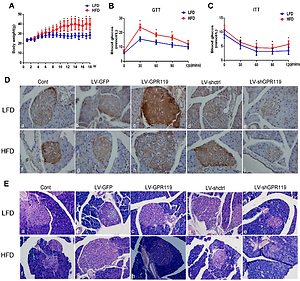Current issue
Archive
Manuscripts accepted
About the Journal
Editorial office
Editorial board
Section Editors
Abstracting and indexing
Subscription
Contact
Ethical standards and procedures
Most read articles
Instructions for authors
Article Processing Charge (APC)
Regulations of paying article processing charge (APC)
DIABETOLOGY / RESEARCH PAPER
Lipotoxicity induced pancreatic beta cell damage is associated with GPR119/MST1/FoxO1 Pathway
1
Ningxia Medical University, China
2
Wright State University, United States
Submission date: 2020-05-30
Final revision date: 2020-08-05
Acceptance date: 2020-08-20
Online publication date: 2021-04-30
KEYWORDS
TOPICS
ABSTRACT
Introduction:
G-protein-coupled receptor 119 (GPR119) is emerging as a potential therapeutic target against type 2 diabetes with beneficial effects on glucose homeostasis. However, the function of GRP119 in lipotoxicity induced pancreatic beta cell apoptosis and the molecular mechanism remains largely unknown.
Material and methods:
Impact of GPR119 on pancreatic islet beta cell apoptosis was evaluated in INS-1 cells treated with palmitate. The subsequent modulation of the MST1-FOXO1-Pdx1 signaling pathway and pro-apoptotic caspase-3 system were determined by measuring the target protein and mRNA expression. Dyslipidemia mice with gain and loss of GPR119 function by the application of specific lenti-viral vector was utilized to evaluate the impact of GPR119 on pancreas function in vivo. Lipid metabolism, glucose and insulin response, morphological changes as well as activation/inhibition of MST1-FOXO1-Pdx1 signaling pathway in pancreas were analyzed systematically.
Results:
Palmitate treatment stimulated pro-apoptotic response in INS-1 cells, accompanied by inhibition of GPR119 expression and the subsequent activation of the MST1-FOXO1 combined with inhibition of Pdx1 signaling cascade. Activation of GPR119 by MBX prevents INS-1 cell from lipotoxicity induced apoptosis by targeting the MST1-FOXO1-Pdx1 pathway. Moreover, overexpression of GPR119 significantly attenuates the dyslipidemia and dysfunction of the pancreas. In contrast, inactivation of GPR119 by lentiviral vector in mice results in accelerated pancreas apoptosis and malfunction. The protective effects of GRP119 on lipotoxicity induced pancreas dysfunction are associated with modulating the MST1-FOXO1-Pdx1 signaling cascade.
Conclusions:
GPR119 alleviates lipotoxicity induced pancreatic beta cell apoptosis and malfunction through regulating MST1-FOXO1-Pdx1 signaling pathway.
G-protein-coupled receptor 119 (GPR119) is emerging as a potential therapeutic target against type 2 diabetes with beneficial effects on glucose homeostasis. However, the function of GRP119 in lipotoxicity induced pancreatic beta cell apoptosis and the molecular mechanism remains largely unknown.
Material and methods:
Impact of GPR119 on pancreatic islet beta cell apoptosis was evaluated in INS-1 cells treated with palmitate. The subsequent modulation of the MST1-FOXO1-Pdx1 signaling pathway and pro-apoptotic caspase-3 system were determined by measuring the target protein and mRNA expression. Dyslipidemia mice with gain and loss of GPR119 function by the application of specific lenti-viral vector was utilized to evaluate the impact of GPR119 on pancreas function in vivo. Lipid metabolism, glucose and insulin response, morphological changes as well as activation/inhibition of MST1-FOXO1-Pdx1 signaling pathway in pancreas were analyzed systematically.
Results:
Palmitate treatment stimulated pro-apoptotic response in INS-1 cells, accompanied by inhibition of GPR119 expression and the subsequent activation of the MST1-FOXO1 combined with inhibition of Pdx1 signaling cascade. Activation of GPR119 by MBX prevents INS-1 cell from lipotoxicity induced apoptosis by targeting the MST1-FOXO1-Pdx1 pathway. Moreover, overexpression of GPR119 significantly attenuates the dyslipidemia and dysfunction of the pancreas. In contrast, inactivation of GPR119 by lentiviral vector in mice results in accelerated pancreas apoptosis and malfunction. The protective effects of GRP119 on lipotoxicity induced pancreas dysfunction are associated with modulating the MST1-FOXO1-Pdx1 signaling cascade.
Conclusions:
GPR119 alleviates lipotoxicity induced pancreatic beta cell apoptosis and malfunction through regulating MST1-FOXO1-Pdx1 signaling pathway.
Share
RELATED ARTICLE
We process personal data collected when visiting the website. The function of obtaining information about users and their behavior is carried out by voluntarily entered information in forms and saving cookies in end devices. Data, including cookies, are used to provide services, improve the user experience and to analyze the traffic in accordance with the Privacy policy. Data are also collected and processed by Google Analytics tool (more).
You can change cookies settings in your browser. Restricted use of cookies in the browser configuration may affect some functionalities of the website.
You can change cookies settings in your browser. Restricted use of cookies in the browser configuration may affect some functionalities of the website.



